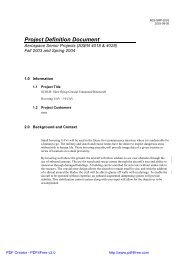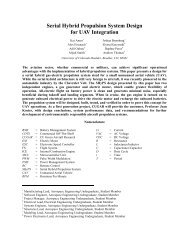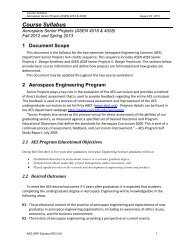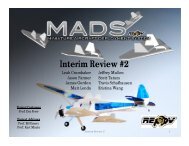PFR - Aerospace Engineering Sciences Senior Design Projects ...
PFR - Aerospace Engineering Sciences Senior Design Projects ...
PFR - Aerospace Engineering Sciences Senior Design Projects ...
Create successful ePaper yourself
Turn your PDF publications into a flip-book with our unique Google optimized e-Paper software.
Project Final Report – CUDBF April 30 th , 2009<br />
ASEN 4028: <strong>Aerospace</strong> <strong>Senior</strong> <strong>Projects</strong><br />
Table 5: Characteristics of the Top Three Airfoils Analyzed<br />
Airfoil % t/c C l max C d (at Cl mx) C m (at cruise) Stall AOA (deg)<br />
Eppler216 10.40 1.78 0.0446 -0.1925 13.27<br />
HS520 8.84 1.42 0.0306 -0.0059 13.70<br />
HS602 10.21 1.38 0.0339 -0.101 12.60<br />
5.2 Missions Subsystem <strong>Design</strong> Alternatives<br />
The design alternatives for the Missions subsystem was broken into three separate elements: the<br />
wing mounted stores, the centerline store, and the aircraft container. Each of these were vital to<br />
the mission of the aircraft and its performance at competition. The design process included a<br />
complete understanding of the score sensitivities and the importance of store load times, an<br />
analysis of the loads acting on these stores, consideration of multiple design alternatives, testing<br />
of those alternatives, an educated selection based on the test results, and finally a successful<br />
implementation of the design choice. Based on established requirements, it was imperative the<br />
stores load quickly, release reliably, and do not release in flight.<br />
5.2.1 Wing Store Release Mechanism<br />
From the sensitivity analysis, the loading of these stores has a large effect on the aircraft’s score<br />
at competition. This loading time factors into both the System Complexity Factor score of the<br />
aircraft through its effect on assembly time, and wing store loading time is measured directly for<br />
the score in Mission 3 (the heaviest weighted mission). It was therefore important that the<br />
release mechanisms for these stores have the ability to load quickly, and this is a key design<br />
driver. It was also important the store release on the ground and not while in flight. To this end,<br />
the release mechanism must release 95% of the time while being able to constrain the store under<br />
flight conditions and loads. These flight conditions include a 3 g force in the aircraft’s Z-axis<br />
and a 1.73 g lateral force. These design-to loads were determined from Figure 15.<br />
Figure 15: FBD and Summary of Equations Calculating Centripetal Force on Wing Stores<br />
34
















